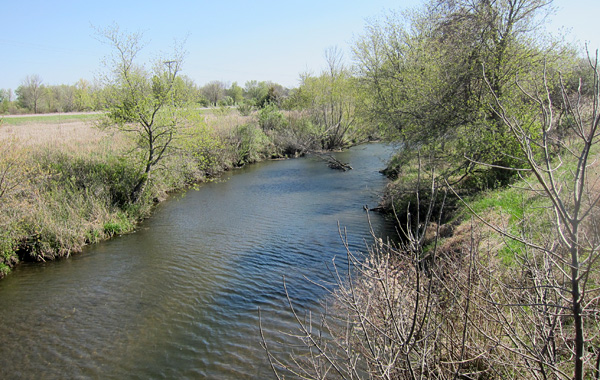 Report from Environment Iowa Research and Policy Center –
Report from Environment Iowa Research and Policy Center –
Des Moines, Iowa — Industrial facilities dumped over 6.2 million pounds of toxic chemicals into Iowa’s waterways, according to a new report released today by Environment Iowa and coauthored by the Frontier Group. Iowa ranks 15th in the nation for this kind of dumping. The report — Wasting Our Waterways: Industrial Toxic Pollution and the Unfulfilled Promise of the Clean Water Act — also discloses that 226 million pounds of toxic chemicals were discharged into 1,400 waterways across the country.
Environment Iowa was joined by other speakers at a press conference today at the Des Moines Chapter of the Izaak Walton League, which is celebrating it’s 90th birthday this year.
“Iowa’s waterways are embarrassingly polluted right now. Polluters dump over 6.2 million pounds of toxic chemicals into Iowa’s rivers and streams every year,” said Samantha Chadwick, the Preservation Advocate with Environment Iowa. “It’s time to turn the tide of toxic pollution and restore Iowa’s waterways to health. For one thing, we should restore Clean Water Act protections to all our waterways.”
Rep. Chuck Isenhart, State Representative from Dubuque, called for more action in Iowa and nationally to address pollution problems. He noted that while there are state and regional governmental bodies working to address water pollution, some formed after the 2008 floods, more partnerships are needed to “make restoring clean water in Iowa and the Midwest a long-term priority.”
The Environment Iowa report documents and analyzes the dangerous levels of pollutants discharged to America’s waters by compiling toxic chemical releases reported to the U.S. EPA’s Toxics Release Inventory for 2010, the most recent data available.
Major findings of the report include:
• The Beaver Channel, which runs through Clinton, IA along the Mississippi River, is ranked 39th in the country for discharges of cancer-causing chemicals, at 6,912 pounds in 2010. Many industrial operations processing food, chemical, and other products in the area have caused pollution problems along the channel for years.
• After the Mississippi, the Des Moines River is 2nd in the state for toxic releases, with 1,140,998 pounds. Following in order are the Iowa River with 981,225 pounds, the Cedar River with 721,163 pounds, the Raccoon River with 384,042 pounds, Silver Creek with 364,758 pounds, then Hecker Creek with 340,668 pounds. There are 47 Iowa waterways for which some toxic dumping was reported in the 2010 TRI data.
• The Mississippi River is ranked 2nd for total toxic discharges nationally, with 1,874,430 pounds of toxics dumped in Iowa specifically and 12.7 million pounds dumped from facilities all along its course through 10 states. The Missouri River is 7th nationally, with nearly 4.9 million pounds dumped along 5 states through which it flows, 104,311 of those pounds are dumped into the Missouri River in Iowa.
• Roquette America Inc. was the biggest polluter in Iowa, dumping 1.7 million pounds of toxic chemicals into the Mississippi. Roquette America Inc was the 24th biggest polluter in the country, followed closely by another Iowa facility, Tyson Fresh Meats Inc. at 25th.
• Three of Iowa’s watersheds ranked in top 30 for most polluted in the nation. The Blackbird-Soldier watershed along the Nebraska border ranked 6th, with 4.7 million pounds. Coming in at 27th was the Flint-Henderson watershed along the border with Illinois, 1.8 million pounds. In 30th place was the Lower Iowa watershed, which includes Iowa City, at 1.7 million pounds.
The report summarizes discharges of cancer-causing chemicals, chemicals that persist in the environment, and chemicals with the potential to cause reproductive problems ranging from birth defects to reduced fertility. Among the toxic chemicals discharged by facilities are arsenic, mercury, and benzene. Exposure to these chemicals is linked to cancer, developmental disorders, and reproductive disorders.
Steve Roe, the President of the Raccoon River Watershed Association noted another reason water quality is so important “half a million people depend on water from the Raccoon and Des Moines rivers for their drinking water.”
Jerry Peckum, a corn and soybean farmer and Board Chair of the group Iowa Rivers Revival, talked about concerns he hears when talking to people who count on Iowa’s rivers for recreation: “The questions come: Why is it brown? Why is it green? Are the fish safe to eat? Where are the fish? Is it safe to swim in a river? What causes the foam? Why does it smell like manure?”
Jerry also talked about the role of agricultural pollution in fouling Iowa’s waterways and the need to realize the goals of the Clean Water Act, passed 40 years ago this year. “When you look at all the industrial related discharges to the water and the heavy toll of agricultural runoff we know the standards and rules are far too weak. It is time we all accept responsibility, work to find solutions, and accept the standards and rules that we must have to achieve clean water.”
“There are common-sense steps that we can take to turn the tide against toxic pollution of our waters,” added Chadwick.
In order to curb the toxic pollution threatening Iowa’s rivers, Environment Iowa recommends the following:
1. Pollution Prevention: Industrial facilities should reduce their toxic discharges to waterways by switching from hazardous chemicals to safer alternatives.
2. Protect all waters: The Obama administration should finalize guidelines and conduct a rulemaking to clarify that the Clean Water Act applies to all of our waterways – including the 44,432 miles of streams in Iowa and 667 thousand Iowans’ drinking water for which jurisdiction under the Clean Water Act has been called into question as a result of two polluter-driven Supreme Court decisions in the last decade.
3. Tough permitting and enforcement: EPA and state agencies should issue permits with tough, numeric limits for each type of toxic pollution discharged, ratchet down those limits over time, and enforce those limits with credible penalties, not just warning letters.
“The bottom line is that our waterways shouldn’t receive so much pollution. Our rivers are too important to the health of the state and our quality of life. We need cleaner water now, and we are counting on our leaders to act to protect our health and our environment,” said Chadwick.
Rep. Isenhart pointed to the importance of national action as well: “we also need the federal government to be a lead partner, because unified regulatory policies and national commitment are essential to success. With that in mind, I have introduced a resolution in the Iowa House calling on Congress to update the Toxic Substances Control Act, which has not been reviewed since its adoption in 1976.








Anonymous, that figures! I am so sick of whining farmers…millionaires, all of them. Greed and politicians have ruined Iowa. I wonder if our local state senator (ragan?) is for local control in regards to confinements? The big city senators get bought out by the pork lobby and stick it to everyone else.
Actually, the corporate hog confinements “factory farms” are the biggest polluter in the state of Iowa. They take advantage of antiquated laws meant to protect the family farm to spew and store thousands of tons of hog manure. Confinements under 2,500 hundred head are basically unregulated and can locate juste 1250 feet from residential property. Pigs weren’t meant to be confined and manure was not meant to be accumulated by the ton in pits. You would be surprised at how many fish kills are caused by confinements yearly. Scary stuff. Bottom line, if a non farm company wanted to build a factory that produced the same emissions as a hog confinement, they would never be allowed to build. But hey, our poor farmers need a break, paying taxes on $10,000 an acre land is expensive.
Howie, I have a challenge for you. Find me an acre of $10,000 farm land that is actually assessed at $10,000. You won’t find it. Farmland isn’t assessed at it’s market value. Some land in Mason City recently sold for $9,000 an acre. It’s assessed at about $3,000 and then gets a rollback from that. It’s the biggest form of corporate welfare in the state.
You better check out the story today in the GG about the DNR fire in Lake Mills. Read the comments. One farmer even claims the boaters and tubers are doing as much damage.
Don’t this make you want to go over to Charles City and do some river rafting? Your ok as long as you don’t get wet.
Farmers the great conservationists. Take a ride out in the country. Look and see how many farmers have taken out their fence lines so they plow into the ditches so they can get an extra acre of corn planted. Reap and pillage the land for the almighty dollar. So forget CES maybe the Max and the group that was against CES should take on the farming industry and not only kill businesses from coming to Mason City but maybe the entire state of Iowa. Wouldn’t that be something.
WOW and to think we were going to have the DNR and EPA and WXYZ watch over the CES plant for us, WOW!!!! Thank God for the Clean Water Act, and How about that Clean Air Act?? HAVE YOU SMELLED VICOR TODAY????. ARMPIT OF IOWA = MASON CITY AND VICOR!!!!!!!